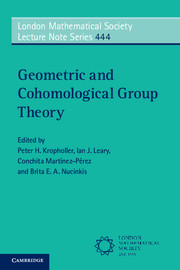Book contents
- Frontmatter
- Contents
- List of Participants
- Preface
- Obstructions for subgroups of Thompson's group V
- Groups of homological dimension one
- Braided diagram groups and local similarity groups
- On Thompson's group T and algebraic K-theory
- Special cube complexes (based on lectures of Piotr Przytycki)
- A hyperbolic group with a finitely presented subgroup that is not of type FP3
- The structure of Euclidean Artin groups
- Finitely presented groups associated with expanding maps
- On characteristic modules of groups
- Controlled algebra for simplicial rings and algebraic K-theory
- References
Groups of homological dimension one
Published online by Cambridge University Press: 11 October 2017
- Frontmatter
- Contents
- List of Participants
- Preface
- Obstructions for subgroups of Thompson's group V
- Groups of homological dimension one
- Braided diagram groups and local similarity groups
- On Thompson's group T and algebraic K-theory
- Special cube complexes (based on lectures of Piotr Przytycki)
- A hyperbolic group with a finitely presented subgroup that is not of type FP3
- The structure of Euclidean Artin groups
- Finitely presented groups associated with expanding maps
- On characteristic modules of groups
- Controlled algebra for simplicial rings and algebraic K-theory
- References
Summary
Abstract
We report on recent work concerning groups of homological dimension one and detail some methods that may be used in order to determine whether these groups are locally free.
Introduction
Stallings has established in [20] a characterization of finitely generated free groups, as those groups whose cohomological dimension is one. It is very easy to show that a free group has cohomological dimension one. Indeed, if G is a free group then the augmentation ideal I G is a free ZG-module; in fact, if G is freely generated by a subset S, then I G is a free ZG-module on the set ﹛s − 1 : s ∈ S﹜. The essence of Stallings’ theorem is that the converse implication is also true, namely that any finitely generated group of cohomological dimension one is free. Bieri asked in [2] whether a (stronger) homological version of the latter result holds:
Is any finitely generated group of homological dimension one free?
Shortly after the publication of the proof of Stallings’ theorem, Swan showed that the finite generation hypothesis is redundant therein, by proving that a (not necessarily finitely generated) group G is free if and only if cd G = 1 (cf. [21]). In that direction, we note that Bieri's question may be equivalently formulated as follows:
Is any group of homological dimension one locally free?
Some interesting results concerning that problem have been obtained in [5] and [11], by embedding the integral group ring ZG of the group G into the associated von Neumann algebra NG and the algebra UG of unbounded operators which are affiliated to NG.
We note that a group G is known to be finitely generated if and only if the augmentation ideal IG is a finitely generated ZG-module, whereas G has homological dimension one if and only if I G is a flat ZG-module. In view of the above mentioned result of Stallings and Swan, the freeness of G is equivalent to the projectivity of IG as a ZG-module.
- Type
- Chapter
- Information
- Geometric and Cohomological Group Theory , pp. 5 - 14Publisher: Cambridge University PressPrint publication year: 2017



